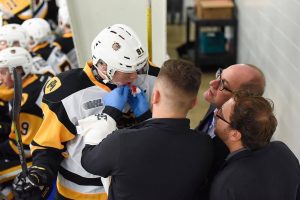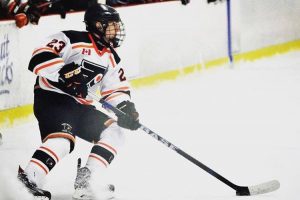By: Brittany Butler and Sara Jabakhanji
Injury and hockey go hand-in-hand. So what’s the cost of burden?
The National Hockey League has been underway for just over a month and already there have been over 90 reported player injuries, according to The Sports Network.
As these players miss crucial time on the ice, teams are required to pay their full salary.
Just yesterday, injured Leafs star Auston Matthews confirmed he would miss a fourth game as he deals with an upper-body injury. The injury will cost the team $45,120 as they continue to pay the centre’s salary.
In research conducted by the British Medical Journal, a total of 50.9 per cent of all NHL players missed at least one game within the 2011 to 2012 season of play. These injuries represent a total salary cost of $218 million USD.
However, the cost of injury goes beyond the economic consequence, as the sight of bloodied players is no shock on the ice rink.

Athletic therapist for the Hamilton Bulldogs OHL Hockey Club, Roman Kaszczij, treats a variety of injuries in any given game.
“Obviously, with any fast-paced, contact sport the risk of injury is always present,” Kaszcsji said. “Constant collisions with other players, the boards, sticks, pucks and the ice are sure to leave many athletes sore after games.
“You have some games where it seems like everything is going right and others where it seems everyone is dropping like flies.”
The most common of these injuries is a concussion.
Four concussions later
The number of concussions among those 18 years and younger is between 1.1 million and 1.9 million annually, according to a 2016 study in the journal Pediatrics.
The NHL has been under a lot of scrutiny in recent years after several players were found to have had concussions at the time of their deaths. As a result, many doctors have began to criticize concussion protocols and shifted their focus to the effects concussions have on children and teens that play hockey.
Former hockey player, Julian Florindi, began playing hockey at three years old and has suffered one major concussion and three minor concussions since.
“I was blacked out for like five minutes on the ice, when I woke up I went to the hospital where I had to stay for two days.” – Julian Florindi
Florindi’s first concussion, which he refers to as his worst one, occurred when he was 15 years old: “I was blacked out for five minutes on the ice, when I woke up I went to the hospital where I had to stay for two days,” he said.
Three minor concussions followed when Florindi began playing center for the Don Mills Flyers.
He was on bed rest for two months after the incident and was unable to attend school for six months due to the critical condition of his concussion.
Roman Kaszczij said it’s important to be consistent and thorough during the return to play process. “Most protocols follow a step-wise process that ensures certain goals are met symptom-free before progression,” Kaszczij said.
Some players experience the symptoms right away while others may experience different and delayed symptoms, Kaszczij said. “A player may feel fine after a hit, but then one shift later will complain of worsening symptoms.”

“I played AAA my whole life. Hockey was my entire life” – Julian Florindi
“I played AAA my whole life. Hockey was my entire life, I was planning on making a future playing hockey so my parents were just trying to help me get the quickest recovery possible and get back on the ice,” Florindi said.
After his fourth concussion at the age of 18, doctors told Florindi he can no longer play hockey or any other contact sport as it would put him in high risk of long-term brain damage.
Florindi said that although his first concussion was incredibly critical, he never considered quitting hockey and neither did his parents.
“My parents and I never thought of my concussions stopping me, we just thought of it as a delay. I would just get right back in the game after them.”
Florindi continues to experience headaches and migraines even after he stopped playing hockey. “I get random headaches throughout the day, even when I am not doing anything physical,” he said.
When asked if there are preventative measures that he could have taken to prevent the concussions from happening, Florindi said there isn’t much besides the equipment that would prevent such occurrences.
“We have all these helmets that are supposed to shield us from head injuries, but my first concussion cracked my helmet in half.”
From a father’s perspective
An ankle and back injury obtained in a 2015 Florida Panthers NHL game has left Dave Bolland with the uncertainty of ever returning to the league again.
His father, Drew Bolland, remembers the incident as a traumatic moment in his son’s life.
“It was sad to see that the chances of his ankle ever being strong enough to play in the NHL are limited,” Drew said.
“Mentally, it’s affecting him. He’d rather be playing than sitting on the sidelines.” – Drew Bolland
“Mentally, it’s affecting him. He’d rather be playing than sitting on the sidelines. It’s tough for him and the family. It’s really hard for me to watch without seeing him up there with them.”
And while his son continues to put in the hard yards in rehabilitation training and exercise, he is still unable to skate.
What can be done to prevent injury?
Roman Kasczij believes there is “no doubt” the league can do more to minimise the likelihood of injury.
“The amount of screening tools available for our disposal is large and continuously growing. However, it’s more than just screening for risks. It is important to take that information and develop an individualized plan for the athlete; a plan that will help address potential imbalances or weaknesses,” he said.
Chiropractor, Dr. Matthew Serrick, echoes this sentiment, and recommends taking preventative measures to avoid hockey-related injuries.
“You want to make sure you’re doing proper functional warm-ups and stretching to make sure your muscles and your body are ready to do the sport you need to do. Listen to your body and if you feel that you’re overdoing it, take it easy,” he said.
“If you are feeling any kind of pain doing any activity, get it checked out. So many times injuries are easier to treat if you see us [medical professionals] sooner.”
Video: Hockey season is underway in Canada, and both professionals and youth must take injuries and concussions seriously, says local chiropractor Dr. Matthew Serrick.
(Trevor G, Rosemary A/RSJ)


Leave a Reply